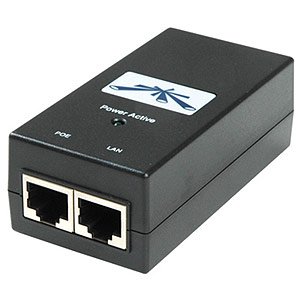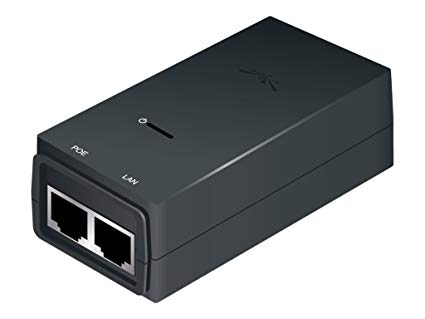
PoE Adapter

Another PoE adapter
A computer network is a complex organism, and its functionality depends on many components and systems. Occasionally any of these can fail. When this happens, we're interested in restoring the network as quickly as possible.
In the interest of this, we've put together this document based on our experience so far. Over half of our support calls are solved by the few simple steps outlined below. More often than not, you'll be able to restore network connectivity quickly and easily on your own.
Make sure it's plugged in
Believe it or not, the most common problem we see is that the client's equipment has simply gotten unplugged - by accident, or by someone looking for a place to plug something else in. Make sure the AC adapter that powers the antenna gear outside (see below) is plugged into an AC outlet or power-strip (and that the power strip is on). If you have a router, make sure that's plugged in, too.
Power-cycle your antenna equipment. The "POE adapter" provides power to the antenna outside.
PoE Adapter Another PoE adapter

The most common problem seems to be a lock-up of the piece of equipment (the antenna) that translates your network traffic into radio signals. This gear gets it's power from inside the house, over the network cable, via a power-over-ethernet ("PoE") adapter. It has 2 network plugs and one power plug, and is located near where the cable from the antenna enters your house.
To
power-cycle your antenna gear: unplug POE adapter's power plug from the
wall or power strip, wait a few moments, and then plug it back in.
Just
make sure you are unplugging/replugging the right one! Often
there is more than one AC adapter. While you are at it, you might give each of the network cables a push to make sure they are firmly plugged in.
Power-cycle your router
Customers with a router should power-cycle the router AFTER the antenna gear. To power-cycle a router: unplug the round power plug from the back, wait a few moments, and plug it back in.
Restart your computer
Unfortunately, today's most popular operating systems (while feature-rich) are not as reliable as they could be. Often network connectivity issues can be solved simply by rebooting the computer.
Of course, sometimes network problems aren't solved by any of the steps above. In these cases, it's almost certainly time to call us. When you do call, our support will be quickest and most effective if you have a few bits of information ready. The following things are what we will almost always want to know first, as soon as we're on the phone with you:
Is your antenna is still attached to the house, and aimed in the right general direction?
If you have a router, are there lights on it? If not, it probably isn't getting power. If so, note if the WAN or INTERNET light is liti (sometimes it's a planet icon). It should be; if it isn't, it indicates that your router isn't sensing the network link to the antenna gear. This can be due to a cable problem, loss of power to the antenna gear, a zapped Internet port on the router, and many other things. You might be able to get the Internet light to come back on by simply making sure all network cables are tightly plugged in.
Did the outage coincide with any weather events, like thunderstorms, heavy rain, or snow?
For Advanced Users
If you are feeling adventurous and are comfortable with computers, there are a few more complicated things you can try.
Confirm your computer's network settings
Your computer's network card ("Local Area Connection" in Windows-speak, "Built-in Ethernet" in Mac-speak) should be set to use "DHCP", or "Get Address Automatically".
(DHCP stands for 'Dynamic Host Configuration Protocol'. This is a method for configuring a computer's network settings over the network. It allows your computer to obtain it's address and other critical network settings automatically from Nedernet's servers (or your router) so that you don't have to be responsible for keeping track of all these settings yourself.)
You can check to see if your computer is getting it's address:
Windows XP/2000: Start Menu->Run->type in "cmd", hit enter, then in the window at the prompt, type "ipconfig".
Mac: System Settings->Network->Show: Built-in Ethernet, under "TCP/IP"
Your IP address should be 192.168.x.y (where x is usually 0,1, 2, or 100, and y is 2 to 254) or 10.x.x.x (where x is anything 1-255). If it is 169.x.x.x, 0.0.0.0, or anything else, there is something wrong. Power-cycle everything. Make sure all cables are plugged in firmly.
Forcing DHCP renewal
You can try to force your computer to renew it's IP address.
Windows XP/2000: Start Menu->Run->type in "cmd", hit enter, then in the window at the prompt, type "ipconfig /release" and hit enter. Then type " ipconfig /renew" and hit enter.
Mac: System Settings->Network->Show: Built-in Ethernet, under "TCP/IP", hit the "DHCP Renew" button.
If it comes back and shows a 192.168.x.x address, your Internet should be working (if not, there may still be a problem with the antenna gear) . If is returns zeros or a 169.x.x.x address, something is still wrong with your router or the antenna gear.
Wireless Router Configuration, 101
Very often we get calls from clients asking how to configure their wireless router – turn on encryption, change the password, change the network name, etc. While this is outside the sphere of Nedernet's responsibility, here are some tips on managing your router.
Opening the Administration Screen (except for Airport base stations)
Most routers have a web-based configuration screen to manage its settings. To access the page, you should, if possible, have your computer plugged into the router with an Ethernet cable (or be connected to it wirelessly). This admin screen is usually accessible in a web browser (Internet Explorer, Firefox, Safari, etc) one of the following addresses:
http://192.168.1.1 (the most common)
(This should be entered in the location or address bar on your web browser.)
You should be presented with a login screen. The default passwords are usually one of the following combinations:
user "admin", password "admin"
user "admin", password "password"
user "admin", no password
If none of these work, it's probable that the password was changed, and if you do not know it, you will have to reset your router to defaults (see below).
Resetting your Router to Default Settings
Sometimes it's necessary to reset your router to it's factory default settings, like when you have forgotten the password. You router should still work for Internet access with the default settings, but any settings you've changed (like the wireless network name) will be lost. To reset the router, there is a special, recessed "reset" button on the back of the router. Just press it (with a paper clip or pencil) and hold for 20 seconds. Then power-cycle the router (unplug from the wall and replug).
Setting up encryption
This can vary widely from router to router, but it usually in the "wireless" or "wireless security" area of the router's configuration pages. We recommend WPA or WPA2 encryption. Enter the passphrase - it has to be 8 or more character. Use a passphrase you won't forget, and we recommend that you write it on a piece of tape and stick it to the router.
Nedernet
Troubleshooting Guide, v2.0 page